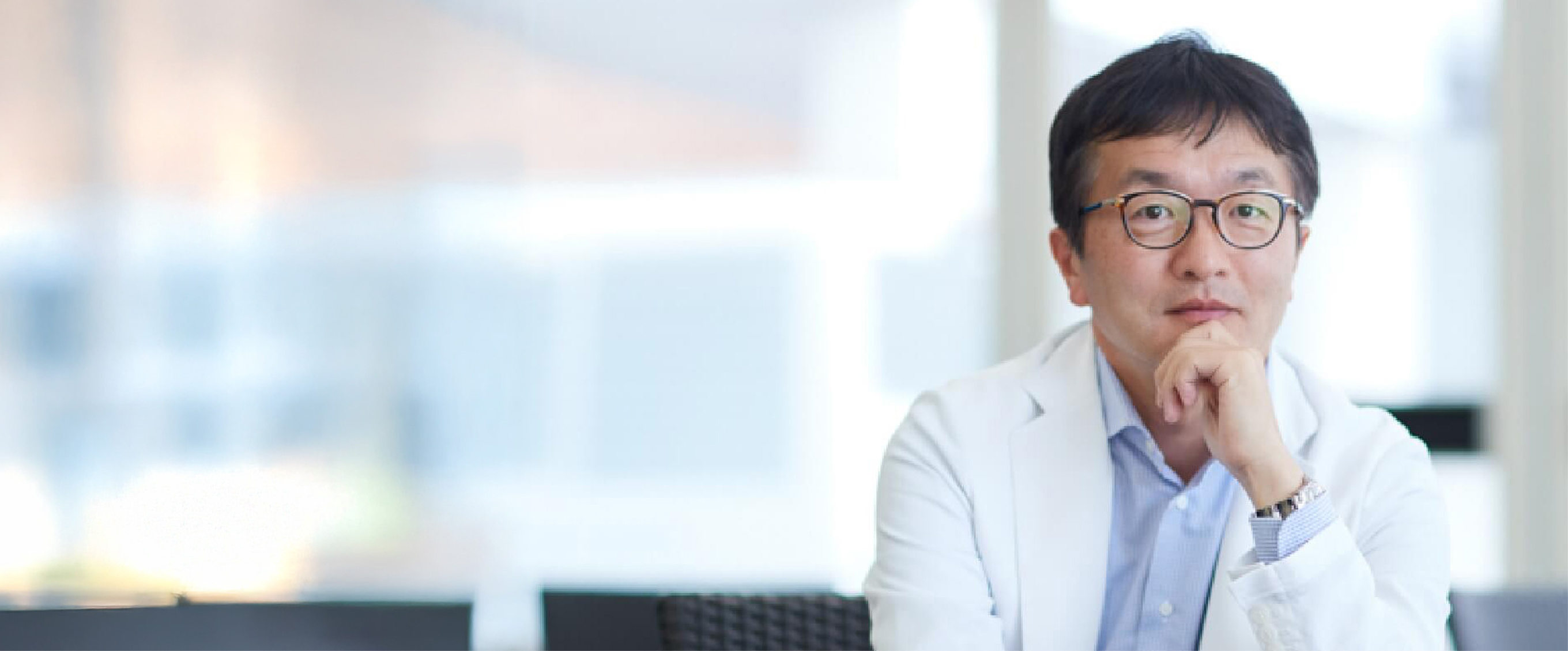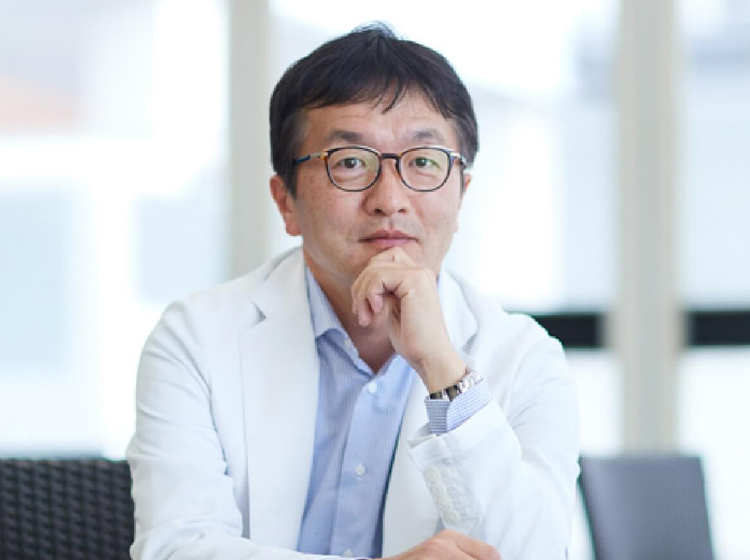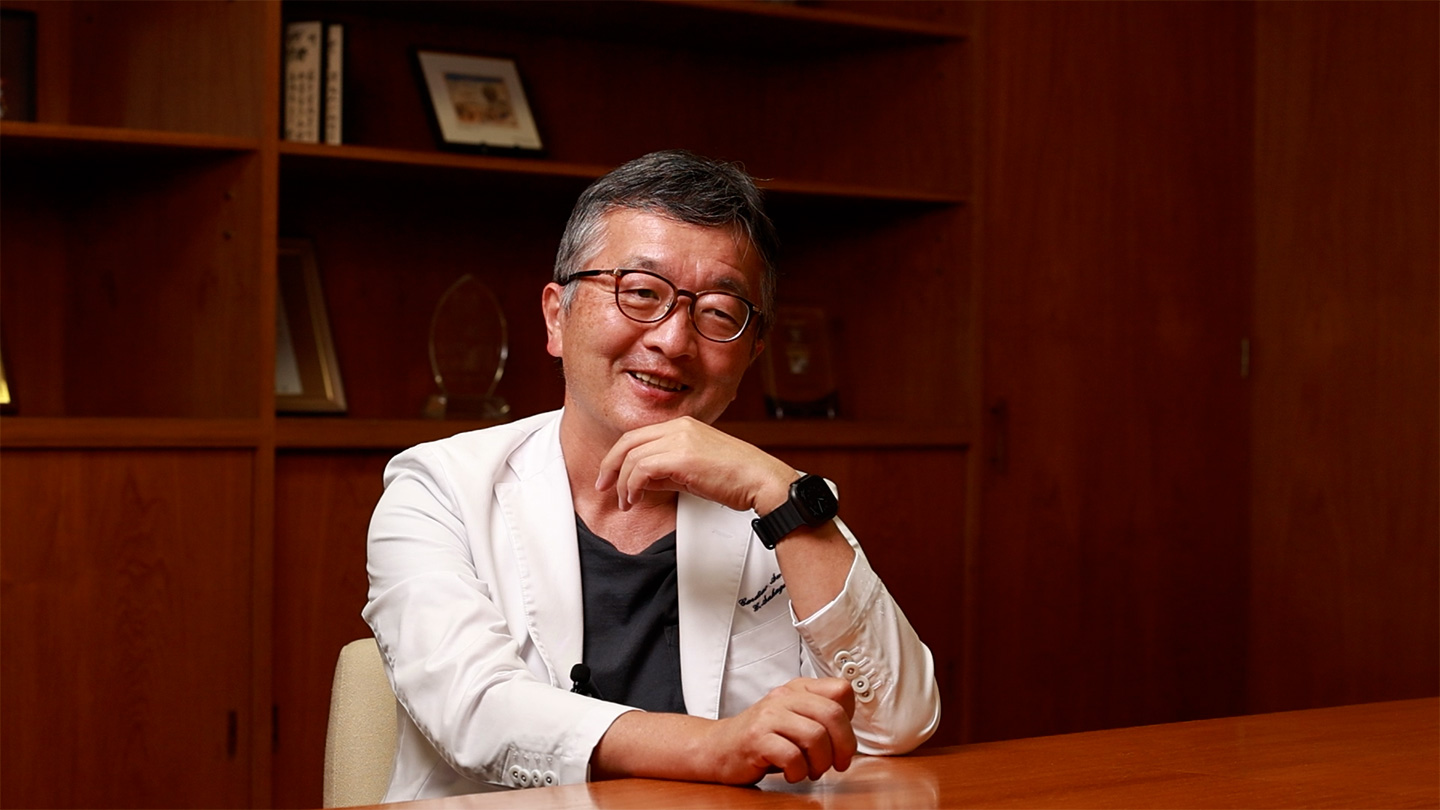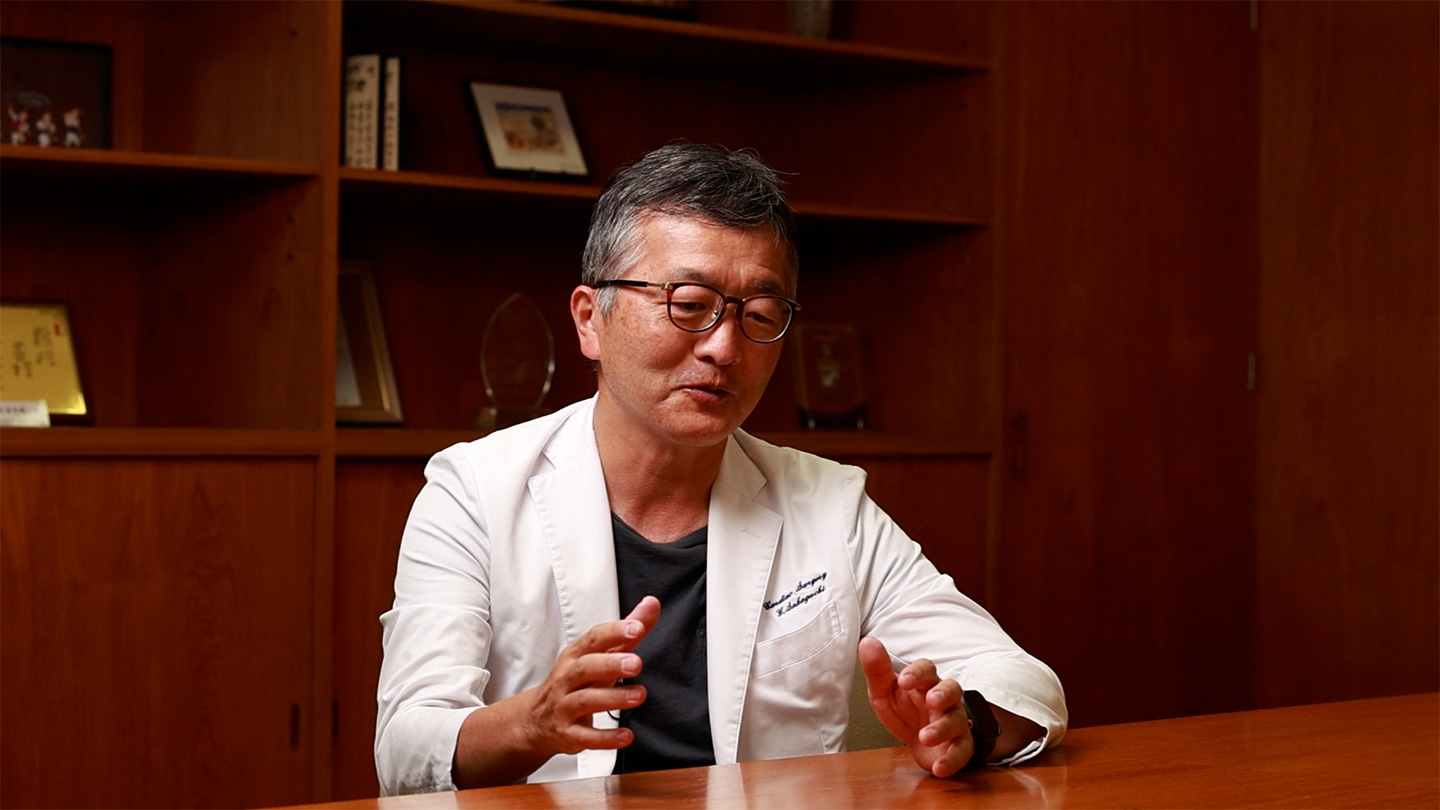Survey or Interview坂口 元一
心臓血管外科はハード。
だからこそ若手に機会を与え
やりがいを感じてもらいたい
Cardiovascular surgery is demanding.That’s why we help young surgeons discover their purpose.


坂口 元一
Interview
SAKAGUCHI Genichi
心臓血管外科学教室 主任教授
Chief Professor of Department of Cardiovascular Surgery
2019年、坂口元一が近畿大学医学部心臓血管外科学教室に就任した直後のことだ。
当時医学部長だった松村到からこう言われた。
「坂口先生は(教授選挙で)学術で選んだのではないです」
論文の質、数ではなく、患者に対する臨床の経験、腕を見込んだという意だった。そして「症例数をどんどん伸ばして欲しい」と続けた。病院長の東田有智が、そのために出来る限りのサポートをすると口を挟んだ。
だから、手術件数の多い自分だったのかと得心する一方、このミッションを達成するには、日本の心臓血管外科のシステムを見直さなければならない、と坂口は覚悟した。
日本において腕のいい心臓血管外科——心臓外科医の数は限られている。まずは勤務時間が長く、肉体的な消耗が激しい。インターネットで「心臓外科医」と検索すると、予測変換で「激務」という単語が出て来る。
もう1つは日本の医療の宿痾と関係がある。医療機関が分散しており、各施設ごとの症例数が少ないことだ。
心臓血管外科に限らず、外科医の手技上達は経験を積むことだ。しかし、各病院の症例数が限られているため、若い医師に執刀の機会が回ってこない。助手など〝下積み〟の期間が長くなるのだ。
坂口の頭にあったのは、30代半ばで留学した、オーストラリアのメルボルン大学オースティン医療センターでの経験だった。
その前に、坂口が心臓血管外科医になるまでを振り返っておこう。
坂口は1965年に兵庫県姫路市で生まれた。曾祖父、祖父、父親が医師という〝医者家系〟である。
「どうせ、お前も医者になるんだろうって、友達からからかわれるのが嫌で、僕はずっと工学部を志望していた。幼稚園から高校までずっと一緒、一つ年下の弟が医学部に行くと言い出したんです。弟が医学部に行くのにぼくは工学部っていうのもあれかなって、最後の最後に医学部を受けることにしたんです」
京都大学医学部では体育会のスキー競技部に入り、1年のうち3ヶ月ほどスキー場に住み込むという生活を送った。4年生で実習が忙しくなり、スキーから離れることになった。
「京大で内科に行く人間はものすごい勉強しているんです。絶対に叶わないので外科系というのは決めていました」
そんなとき、京都大学医学部心臓血管外科教授だった伴敏彦の心臓手術を見学する機会があった。
「心臓を止めて行う手術でした。医者は4人がかり、臨床工学士も3、4人。これはすごい、自分でもやってみたいと思いました」
〈神の宿る心臓だけは傷つけてはならない〉とは古代ギリシャのアリストテレスの言葉だ。臓器の中でも生命維持に最も重要な心臓手術は最も難易度が高い。
心臓血管外科の激務は、坂口も認識していた。あのときはそれもなんか格好いいなと思ったんですよねと笑う。
「(現場では)研修医が一番下。ぼくたちが点滴を作り、レントゲンの現像から全部やらないといけない。手術の時は第2助手、第3助手で入って、後の術後管理を任される。3日間ぐらい泊まるのはざらで、2段ベッドで寝泊まりしてました」
学生時代のクラブ合宿の延長のような感じで、楽しかったですよとうそぶく。
京都大学医学部附属病院から、大阪赤十字病院を経て、1998年にオーストラリアのオースティンチン医療センターに渡る。手技の経験を積むためだった。
「心臓手術件数は、日本だとだいたい1施設あたり年間100程度。当時のオースティンチン医療センターは800でした」
働き方も坂口の常識と全く違っていた。
「朝6時半から病院に集合して、回診した後、7時過ぎからスタートして1日3例の手術。だいたい午後2時半には終わる。3、4時には家に帰って、家族との時間が過ごせる」
オーストラリアで坂口は、体制を構築することの重要性を痛感した。
「オーストラリアでは独立して手術ができる心臓外科医をコンサルタントと呼びます。このコンサルタントはオーストラリア全土で30人〜40人しかいない」
コンサルタントを中心に助手の医師でチームを作り手術を行う。坂口もその助手の1人だった。
術中の雰囲気も全く違っていた。
「日本では(執刀医から)怒鳴り散らされることもありました。泣き出す看護師さんがいるような手術でした。ところがオーストラリアでは、世間話をしながら淡々と進める」
その手技は正確で素早い。
「日本では6時間ぐらい掛かった手術が3時間ぐらいで終わる。心臓を止める時間が短いので、(再び繋いだとき)立ち上がってくるのも早い。すごくテンポがいい」
術後管理も役割分担が整備されており、医師が泊まり込むことはなかった。オーストラリアでの経験はその後の坂口の指針となった。
帰国後、国立京都医療センター、倉敷中央病院、静岡県立総合病院、小倉記念病院で勤務した。
中でも印象に残っているのが、静岡県立総合病院だ。心臓の手術件数が少ない心臓血管外科の立て直しを託されたのだ。
「ぼくたちの生活って、起きている時間の90パーセント以上を心臓血管の手術に費やしている。手術が辛ければやっていられない。手術はなるべく早くやる。そして若いドクターにも手術を分担する」
坂口は安全を担保した上で、若手に手術の機会を与えた。仕事にやり甲斐を感じることがなければ、長続きしないじゃないですか、と坂口は言う。
現在、静岡県立総合病院は、心臓血管外科の症例数が多い病院として知られている。
当時医学部長だった松村到からこう言われた。
「坂口先生は(教授選挙で)学術で選んだのではないです」
論文の質、数ではなく、患者に対する臨床の経験、腕を見込んだという意だった。そして「症例数をどんどん伸ばして欲しい」と続けた。病院長の東田有智が、そのために出来る限りのサポートをすると口を挟んだ。
だから、手術件数の多い自分だったのかと得心する一方、このミッションを達成するには、日本の心臓血管外科のシステムを見直さなければならない、と坂口は覚悟した。
日本において腕のいい心臓血管外科——心臓外科医の数は限られている。まずは勤務時間が長く、肉体的な消耗が激しい。インターネットで「心臓外科医」と検索すると、予測変換で「激務」という単語が出て来る。
もう1つは日本の医療の宿痾と関係がある。医療機関が分散しており、各施設ごとの症例数が少ないことだ。
心臓血管外科に限らず、外科医の手技上達は経験を積むことだ。しかし、各病院の症例数が限られているため、若い医師に執刀の機会が回ってこない。助手など〝下積み〟の期間が長くなるのだ。
坂口の頭にあったのは、30代半ばで留学した、オーストラリアのメルボルン大学オースティン医療センターでの経験だった。
その前に、坂口が心臓血管外科医になるまでを振り返っておこう。
坂口は1965年に兵庫県姫路市で生まれた。曾祖父、祖父、父親が医師という〝医者家系〟である。
「どうせ、お前も医者になるんだろうって、友達からからかわれるのが嫌で、僕はずっと工学部を志望していた。幼稚園から高校までずっと一緒、一つ年下の弟が医学部に行くと言い出したんです。弟が医学部に行くのにぼくは工学部っていうのもあれかなって、最後の最後に医学部を受けることにしたんです」
京都大学医学部では体育会のスキー競技部に入り、1年のうち3ヶ月ほどスキー場に住み込むという生活を送った。4年生で実習が忙しくなり、スキーから離れることになった。
「京大で内科に行く人間はものすごい勉強しているんです。絶対に叶わないので外科系というのは決めていました」
そんなとき、京都大学医学部心臓血管外科教授だった伴敏彦の心臓手術を見学する機会があった。
「心臓を止めて行う手術でした。医者は4人がかり、臨床工学士も3、4人。これはすごい、自分でもやってみたいと思いました」
〈神の宿る心臓だけは傷つけてはならない〉とは古代ギリシャのアリストテレスの言葉だ。臓器の中でも生命維持に最も重要な心臓手術は最も難易度が高い。
心臓血管外科の激務は、坂口も認識していた。あのときはそれもなんか格好いいなと思ったんですよねと笑う。
「(現場では)研修医が一番下。ぼくたちが点滴を作り、レントゲンの現像から全部やらないといけない。手術の時は第2助手、第3助手で入って、後の術後管理を任される。3日間ぐらい泊まるのはざらで、2段ベッドで寝泊まりしてました」
学生時代のクラブ合宿の延長のような感じで、楽しかったですよとうそぶく。
京都大学医学部附属病院から、大阪赤十字病院を経て、1998年にオーストラリアのオースティンチン医療センターに渡る。手技の経験を積むためだった。
「心臓手術件数は、日本だとだいたい1施設あたり年間100程度。当時のオースティンチン医療センターは800でした」
働き方も坂口の常識と全く違っていた。
「朝6時半から病院に集合して、回診した後、7時過ぎからスタートして1日3例の手術。だいたい午後2時半には終わる。3、4時には家に帰って、家族との時間が過ごせる」
オーストラリアで坂口は、体制を構築することの重要性を痛感した。
「オーストラリアでは独立して手術ができる心臓外科医をコンサルタントと呼びます。このコンサルタントはオーストラリア全土で30人〜40人しかいない」
コンサルタントを中心に助手の医師でチームを作り手術を行う。坂口もその助手の1人だった。
術中の雰囲気も全く違っていた。
「日本では(執刀医から)怒鳴り散らされることもありました。泣き出す看護師さんがいるような手術でした。ところがオーストラリアでは、世間話をしながら淡々と進める」
その手技は正確で素早い。
「日本では6時間ぐらい掛かった手術が3時間ぐらいで終わる。心臓を止める時間が短いので、(再び繋いだとき)立ち上がってくるのも早い。すごくテンポがいい」
術後管理も役割分担が整備されており、医師が泊まり込むことはなかった。オーストラリアでの経験はその後の坂口の指針となった。
帰国後、国立京都医療センター、倉敷中央病院、静岡県立総合病院、小倉記念病院で勤務した。
中でも印象に残っているのが、静岡県立総合病院だ。心臓の手術件数が少ない心臓血管外科の立て直しを託されたのだ。
「ぼくたちの生活って、起きている時間の90パーセント以上を心臓血管の手術に費やしている。手術が辛ければやっていられない。手術はなるべく早くやる。そして若いドクターにも手術を分担する」
坂口は安全を担保した上で、若手に手術の機会を与えた。仕事にやり甲斐を感じることがなければ、長続きしないじゃないですか、と坂口は言う。
現在、静岡県立総合病院は、心臓血管外科の症例数が多い病院として知られている。
Making use of experiences such as ‘studying abroad in Australia’ and ‘revitalizing cardiovascular surgery,’ he regards Kindai University Faculty of Medicine as the place for the culmination of his efforts in fostering others.
In 2019, shortly after SAKAGUCHI Genichi assumed his position as Chief Professor, Department of Cardiovascular Surgery at Kindai University Faculty of Medicine, he was called upon by then-Dean, MATSUMURA Itaru.“Mister SAKAGUCHI, you were not chosen for your academic record,” MATSUMURA told him.
The implication was clear: it was not the quantity or quality of his papers that had secured him the role, but rather his clinical experience and surgical skill. MATSUMURA continued, “I want you to steadily increase the number of cases you handle.” At that moment, TOHDA Yuji, who was serving as Hospital Director, interjected, promising that he would provide as much support as possible to make that happen.
SAKAGUCHI came to understand why he had been chosen—because of his high surgical case volume. Yet, at the same time, he realized that fulfilling this mission would require more than individual effort. To truly expand case volume, he would need to confront and rethink the very system of cardiovascular surgery in Japan.
For in Japan, skilled cardiovascular surgeons are few in number. The work is grueling: long hours and relentless physical demands. “If you type ‘cardiac surgeon’ into an internet search bar,” he notes, “the predictive text immediately offers the word ‘overwork.’”
Another problem is tied to a chronic weakness of Japan’s healthcare system: its extreme decentralization. Because medical facilities are spread thinly across regions, each hospital handles only a small number of cases.
In cardiovascular surgery, as in all surgical fields, technical mastery comes only through accumulated experience. But with case numbers limited at each hospital, young surgeons have few opportunities to serve as lead operators. Instead, they spend long years in supporting roles, unable to build the practical experience they need.
What came to SAKAGUCHI’s mind was his experience in his mid-thirties studying at the Austin Health Center of the University of Melbourne in Australia.
But before that, it is worth looking back on how SAKAGUCHI first came to walk the path of a cardiovascular surgeon.

話を近畿大学医学部の主任教授就任後に戻そう——。
症例数を伸ばすというミッション達成には、大きな関門があった。その当時、近畿大学医学部に循環器内科の主任教授がいなかったのだ。
心臓に関わる外科=心臓血管外科、内科=循環器内科は表裏一体である。循環器内科での診察の後、心臓血管外科に紹介される患者が少なくない。
「まずは、循環器を標榜している近隣のクリニックに飛び込みで行き、何か心臓で問題がある患者さんがいたら近大の心臓血管外科に紹介してくださいと頼んで回りました」
100軒以上回りましたよと当時を振り返る。
同時に、優秀な循環器内科医を近畿大学に呼んで欲しいとも頼まれた。
「循環器内科はTAVIなどを含めて、若い世代が引っ張っています。そういう若い先生を探しました」
TAVIとは経カテーテル大動脈弁置換術(Transcatheter Aortic Valve Implantation)のことだ。足の付け根などからカテーテルを挿入。大動脈弁に折りたたまれた人工弁を運び、固く開きにくくなった弁を押し広げるという治療法だ。外科と内科の境界にある治療で、坂口もTAVIの臨床試験に関わっている。
「病院によっては、同じ疾患を外科が診るか、内科が診るのかと奪い合いみたいなのがあると聞きます。でも大切なのは患者さんの命を救うこと。心臓血管外科、循環器内科、心臓に関わる〝ハートチーム〟が上手く機能することなんです」
坂口が念頭に置いたのは、近畿大学に赴任する直前に勤務していた小倉記念病院だった。
「小倉ではTAVIを年間300から400例を行っていました。さらに、ぼくたち心臓血管外科の外来が忙しいときは循環器内科の先生が応援してくれたんです」
小倉記念病院の循環器内科にいた後輩に、いい医師を紹介して欲しいと頼むと、東海大学医学部循環器内科学の准教授、中澤学の名前があがった。関東の心臓血管外科の友人の間で中澤が有名になりつつあるという。全く面識はなかったが、メールで中澤に連絡を取り、会うことになった。
中澤の第一印象は「礼儀正しく、ノリがいい」だった。彼とならば理想のハートチームができるという直感があった。そして坂口着任の一年後、2020年に中澤は循環器内科の主任教授となった。
坂口と中澤を中心とした近畿大学病院のハートチームが目指しているのは「ハートコール」の全応需である。
ハートコールとは、心停止や呼吸停止など患者が急変した際の緊急コールシステムのことだ。院内はもちろん、院外から搬送される緊急連絡があった場合、全応需、つまり全ての患者を受け入れる。
「困っている患者さんは断らない。それが心臓血管外科、循環器内科のハートチームが一番大切していることです」
そして近畿大学は坂口がこれまで実践していた後進育成の集大成の場でもある。
「もう、(卓越した手技がある)スタープレーヤーじゃないとできない手術なんてありません」
どのような人間が心臓血管外科医に向いていますかと尋ねると、少し考えた後、答えた。
「腕が良くてもチームを組めない人は難しい。フットワークが軽くて、コミュニケーションがちゃんと取れる人ですかね」
もっとも、心臓血管外科医の現場は決して楽ではない。
坂口は後進にこう呼びかける。
「一生やろうと思わなくてもいいんです。若いうちは、心臓血管外科のような大変だけれど、経験を積める場所に身を置くのもいいんじゃないかな。ちょっとでも興味があるなら挑戦して欲しい」
症例数を伸ばすというミッション達成には、大きな関門があった。その当時、近畿大学医学部に循環器内科の主任教授がいなかったのだ。
心臓に関わる外科=心臓血管外科、内科=循環器内科は表裏一体である。循環器内科での診察の後、心臓血管外科に紹介される患者が少なくない。
「まずは、循環器を標榜している近隣のクリニックに飛び込みで行き、何か心臓で問題がある患者さんがいたら近大の心臓血管外科に紹介してくださいと頼んで回りました」
100軒以上回りましたよと当時を振り返る。
同時に、優秀な循環器内科医を近畿大学に呼んで欲しいとも頼まれた。
「循環器内科はTAVIなどを含めて、若い世代が引っ張っています。そういう若い先生を探しました」
TAVIとは経カテーテル大動脈弁置換術(Transcatheter Aortic Valve Implantation)のことだ。足の付け根などからカテーテルを挿入。大動脈弁に折りたたまれた人工弁を運び、固く開きにくくなった弁を押し広げるという治療法だ。外科と内科の境界にある治療で、坂口もTAVIの臨床試験に関わっている。
「病院によっては、同じ疾患を外科が診るか、内科が診るのかと奪い合いみたいなのがあると聞きます。でも大切なのは患者さんの命を救うこと。心臓血管外科、循環器内科、心臓に関わる〝ハートチーム〟が上手く機能することなんです」
坂口が念頭に置いたのは、近畿大学に赴任する直前に勤務していた小倉記念病院だった。
「小倉ではTAVIを年間300から400例を行っていました。さらに、ぼくたち心臓血管外科の外来が忙しいときは循環器内科の先生が応援してくれたんです」
小倉記念病院の循環器内科にいた後輩に、いい医師を紹介して欲しいと頼むと、東海大学医学部循環器内科学の准教授、中澤学の名前があがった。関東の心臓血管外科の友人の間で中澤が有名になりつつあるという。全く面識はなかったが、メールで中澤に連絡を取り、会うことになった。
中澤の第一印象は「礼儀正しく、ノリがいい」だった。彼とならば理想のハートチームができるという直感があった。そして坂口着任の一年後、2020年に中澤は循環器内科の主任教授となった。
坂口と中澤を中心とした近畿大学病院のハートチームが目指しているのは「ハートコール」の全応需である。
ハートコールとは、心停止や呼吸停止など患者が急変した際の緊急コールシステムのことだ。院内はもちろん、院外から搬送される緊急連絡があった場合、全応需、つまり全ての患者を受け入れる。
「困っている患者さんは断らない。それが心臓血管外科、循環器内科のハートチームが一番大切していることです」
そして近畿大学は坂口がこれまで実践していた後進育成の集大成の場でもある。
「もう、(卓越した手技がある)スタープレーヤーじゃないとできない手術なんてありません」
どのような人間が心臓血管外科医に向いていますかと尋ねると、少し考えた後、答えた。
「腕が良くてもチームを組めない人は難しい。フットワークが軽くて、コミュニケーションがちゃんと取れる人ですかね」
もっとも、心臓血管外科医の現場は決して楽ではない。
坂口は後進にこう呼びかける。
「一生やろうと思わなくてもいいんです。若いうちは、心臓血管外科のような大変だけれど、経験を積める場所に身を置くのもいいんじゃないかな。ちょっとでも興味があるなら挑戦して欲しい」
In Australia, even while performing eight times as many surgeries, it did not feel like overwork.
SAKAGUCHI Genichi was born in 1965 in Himeji City, Hyogo Prefecture, into a long line of physicians—his great-grandfather, grandfather, and father had all been doctors.“I used to hate it when my friends teased me, saying, ‘You’ll become a doctor too, won’t you?’ So for the longest time I planned to go into engineering. But then my younger brother—who had been with me from kindergarten through high school—said he was going to medical school. I thought, if my younger brother is going into medicine, maybe it would be strange for me to go into engineering. So at the very last moment, I decided to apply to medical school,” he recalls.
At the Faculty of Medicine at Kyoto University, SAKAGUCHI joined the competitive alpine ski team, staying at ski resorts nearly three months each year. But by his fourth year, the demands of clinical training forced him to step away from skiing.
“At Kyoto University, those who chose internal medicine studied so intensely. I knew I couldn’t match that, so I had already decided on a surgical path.”
It was around this time that he was given the chance to observe a heart surgery performed by Professor BAN Toshihiko, then head of cardiovascular surgery at Kyoto University Faculty of Medicine.
“It was an operation where they actually stopped the heart. Four doctors worked together, along with three or four clinical engineers. Watching it, I thought, this is incredible. I want to try this myself.”
The ancient Greek philosopher Aristotle once warned, “Only the heart, where the gods reside, must not be harmed.” Among all the organs, the heart is the most essential for sustaining life, and heart surgery is the most demanding of all operations.
SAKAGUCHI knew well the grueling demands of cardiac surgery. “Even back then, I knew it was brutal work… but somehow, that made it seem cool to me,” he says with a smile.
“In the field, interns were at the very bottom. We had to prepare the IV drips, develop the X-rays—everything. During surgeries, we’d be the second or third assistant, then be responsible for post-operative management. Staying at the hospital for three days straight was nothing unusual. We slept in stacked bunk beds right there.”
He shrugs it off, saying it felt like an extension of the ski club training camps he had known in his student club days—tough, but strangely fun.
From Kyoto University Hospital, he moved to Osaka Red Cross Hospital, and in 1998, he made his way to the Austin Health Medical Center in Melbourne, Australia. The goal was simple: to gain as much hands-on surgical experience as possible.
“In Japan, a typical facility performed about a hundred heart surgeries per year. At the Austin Medical Center back then, the number was eight hundred.”
The way of working was also utterly unlike anything SAKAGUCHI had known.
“At 6:30 in the morning, everyone gathered at the hospital. After making the rounds, surgeries began just past 7 o’clock. Three operations were performed in a single day, and usually, everything was finished by about 2:30 in the afternoon. By three or four o’clock, we could head home and spend time with our families.”
In Australia, SAKAGUCHI came to realize the crucial importance of system building.
“In Australia, heart surgeons who can operate independently are called consultants. Across the entire country, there are only about thirty to forty of them.”
Each consultant leads a surgical team composed of assisting doctors. SAKAGUCHI, too, served as one of those assistants. The atmosphere inside the operating room was also entirely different.
“In Japan, it wasn’t unusual for the lead surgeon to shout at everyone during an operation. There were operations where nurses ended up in tears. But in Australia, everything proceeded calmly, almost conversationally, with people even making small talk as they worked.”
And yet, the techniques were astonishingly precise and fast.
“A surgery that took about six hours in Japan would be completed in three. Because the time the heart was stopped was shorter, the recovery after reconnection was faster. The tempo was incredible.”
Postoperative care was also completely systematized. Responsibilities were clearly divided among staff, and no one expected doctors to stay overnight. The experience in Australia would become a lasting touchstone for SAKAGUCHI’s career from then on.
After returning to Japan, he went on to work at the National Hospital Organization Kyoto Medical Center, Kurashiki Central Hospital, Shizuoka General Hospital, and Kokura Memorial Hospital.
Among the many hospitals where he worked, the one that left the deepest impression on SAKAGUCHI was Shizuoka General Hospital. There, he was entrusted with the daunting task of revitalizing its cardiovascular surgery department, which at the time handled only a small number of heart operations.
“In our lives, more than 90 percent of our waking hours are devoted to heart surgery. If surgery feels like drudgery, you can’t keep doing it. So, the operations must be done as efficiently as possible. And young doctors, too, must be given their share of cases.”
While ensuring patient safety, SAKAGUCHI deliberately created opportunities for younger surgeons to operate. If they could not feel the sense of fulfillment that came with the work, he believed they would never last in such a demanding field.
Today, Shizuoka General Hospital is recognized as one of the busiest cardiovascular surgery centers in Japan—a testament to the success of the system he helped build.

Kindai University Faculty of Medicine is the culmination of my lifelong efforts in nurturing the next generation.
Let us return to the period after SAKAGUCHI became professor and chair of cardiovascular surgery at Kindai University Faculty of Medicine.Achieving his mission of increasing surgical case numbers meant overcoming one significant obstacle: at that time, the university had no full professor heading its Department of Cardiology.
Cardiovascular surgery and cardiology are two sides of the same coin. Many patients first visit cardiology for evaluation before being referred for cardiovascular surgery.
“First, I went door-to-door, visiting local clinics that listed cardiology as a specialty. I asked them directly: if you see patients with heart problems, please refer them to our cardiovascular surgery department at Kindai,” he recalls. “I visited more than a hundred clinics.”
At the same time, he was asked to recruit a strong cardiology leader to join Kindai University.
“Cardiology, including procedures like TAVI, is now being driven by the younger generation. I went looking for such a young physician,” he explained.
TAVI—Transcatheter Aortic Valve Implantation— involves threading a catheter through the groin and delivering a folded artificial valve to the aortic valve, pushing open the stiffened native valve. It is a procedure that lies on the border between surgery and internal medicine, and SAKAGUCHI himself had been involved in its clinical trials.
“In some hospitals, I’ve heard that surgery and internal medicine end up fighting over who treats the same heart condition. But what truly matters is saving the patient’s life. What’s essential is that the ‘heart team’—cardiovascular surgery and cardiology—functions together as one,” SAKAGUCHI emphasizes.
In his mind, SAKAGUCHI was drawing on his experience at Kokura Memorial Hospital, where he had worked immediately before coming to Kindai.
“At Kokura, we performed between 300 and 400 TAVI procedures a year. And when our cardiovascular surgery outpatient clinic got overwhelmed, the cardiologists stepped in to help us.”
SAKAGUCHI asked a former junior colleague from Kokura Memorial Hospital’s cardiology department to recommend a strong physician who could help him build such a team at Kindai. The name that came back was NAKAZAWA Gaku, then an associate professor of cardiology at Tokai University School of Medicine, who was quickly gaining recognition among SAKAGUCHI’s colleagues in cardiovascular surgery in the Kanto region.
Though he had never met NAKAZAWA before, SAKAGUCHI sent him an email—and arranged to meet. His first impression was decisive: “He was courteous and had great energy. I immediately felt he was someone I could build an ideal heart team with.”
One year after SAKAGUCHI’s arrival, in 2020, NAKAZAWA became Chief Professor of Cardiology.
The heart team at Kindai University Hospital, led by SAKAGUCHI and NAKAZAWA, set its sights on a clear mission: to respond to every “Heart Call.”
The “Heart Call” is the hospital’s emergency call system, activated when a patient suddenly suffers cardiac arrest, respiratory arrest, or other life-threatening changes. Whether the call comes from within the hospital or from an incoming emergency transfer, the commitment is to accept all patients, without exception.
“We do not turn away patients in need. That,” SAKAGUCHI emphasizes, “is the most important principle for our heart team of cardiovascular surgeons and cardiologists.”
For SAKAGUCHI, Kindai University is also the culmination of his long-held mission to train the next generation.
“There are no surgeries anymore that only ‘star players’ with extraordinary technical skill can perform,” he declared.
When asked what kind of person makes a good cardiovascular surgeon, SAKAGUCHI pauses to consider:
“Even if you’re technically skilled, if you can’t function in a team, it’s difficult. What we need are people who are light on their feet, and can communicate well.”
Still, he does not pretend the work is easy. To younger doctors, he offers this encouragement: “You don’t have to think of it as something you’ll do for your entire life. But while you’re young, it’s worthwhile to place yourself in a demanding field like cardiovascular surgery, where you can accumulate invaluable experience. If you have even a little interest, I hope you’ll give it a try.”